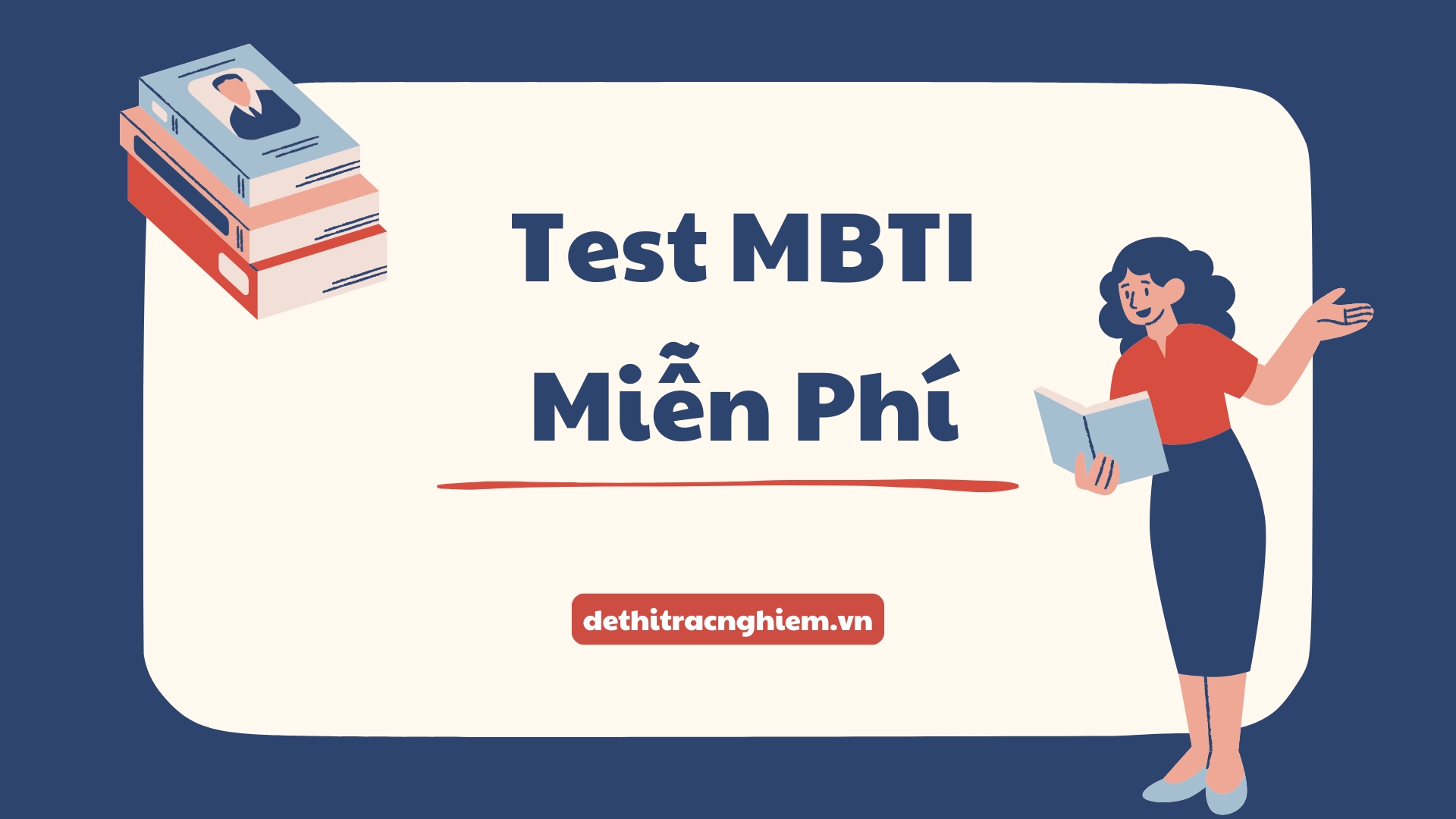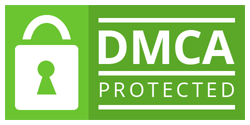Đề thi thử Đại học 2025 môn Tiếng Anh – THPT Nghèn – Hà Tĩnh là một trong những đề tiêu biểu thuộc Tổng hợp đề thi thử môn Tiếng Anh THPT QG, nằm trong chương trình Đề thi vào Đại học. Đây là đề thi được xây dựng sát với định hướng ra đề mới nhất của Bộ GD&ĐT, phù hợp với cấu trúc đề thi tốt nghiệp THPT môn Tiếng Anh năm 2025.
Đề thi này bao gồm đầy đủ các dạng bài quan trọng như: phát âm – trọng âm, ngữ pháp cơ bản và nâng cao, từ vựng theo chủ đề, đọc hiểu, điền từ vào đoạn văn (cloze test) và viết lại câu (sentence transformation). Đặc biệt, phần đọc hiểu và phân tích ngữ cảnh trong đề mang tính phân loại cao, đòi hỏi học sinh không chỉ nắm chắc kiến thức ngôn ngữ mà còn phải có khả năng suy luận, tổng hợp và quản lý thời gian tốt trong quá trình làm bài.
Hãy cùng Dethitracnghiem.vn khám phá ngay đề thi thử này và bắt tay vào luyện tập để sẵn sàng cho kỳ thi THPT Quốc gia sắp tới!
- Số trang: 4 trang
- Hình thức: Trắc nghiệm
- Thời gian làm bài: 50 phút (không kể thời gian phát đề)
ĐỀ THI THỬ ĐẠI HỌC MÔN TIẾNG ANH NĂM 2025 THPT NGHÈN – HÀ TĨNH
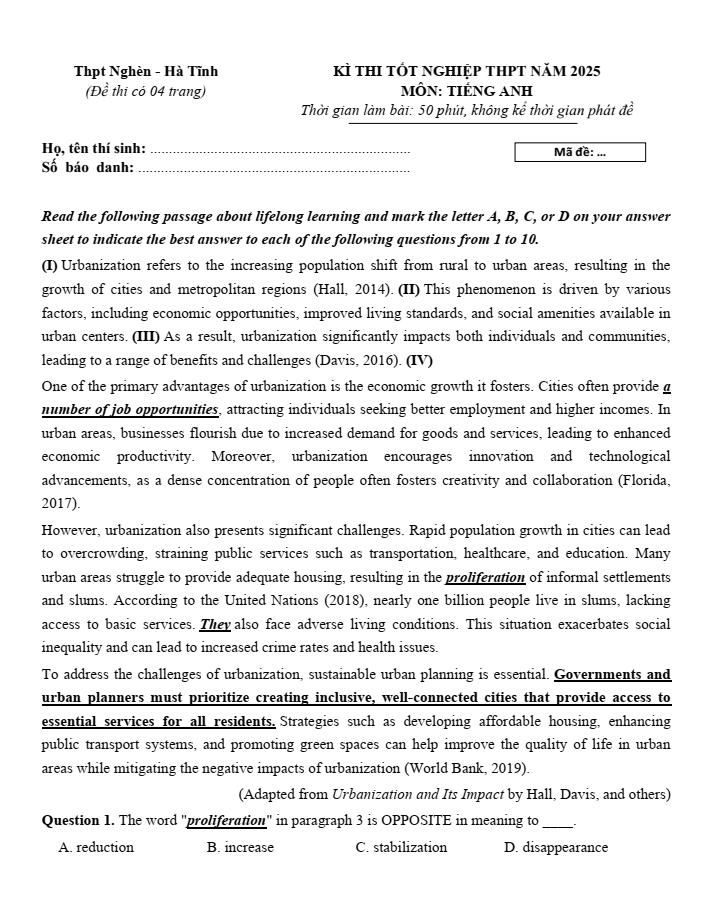
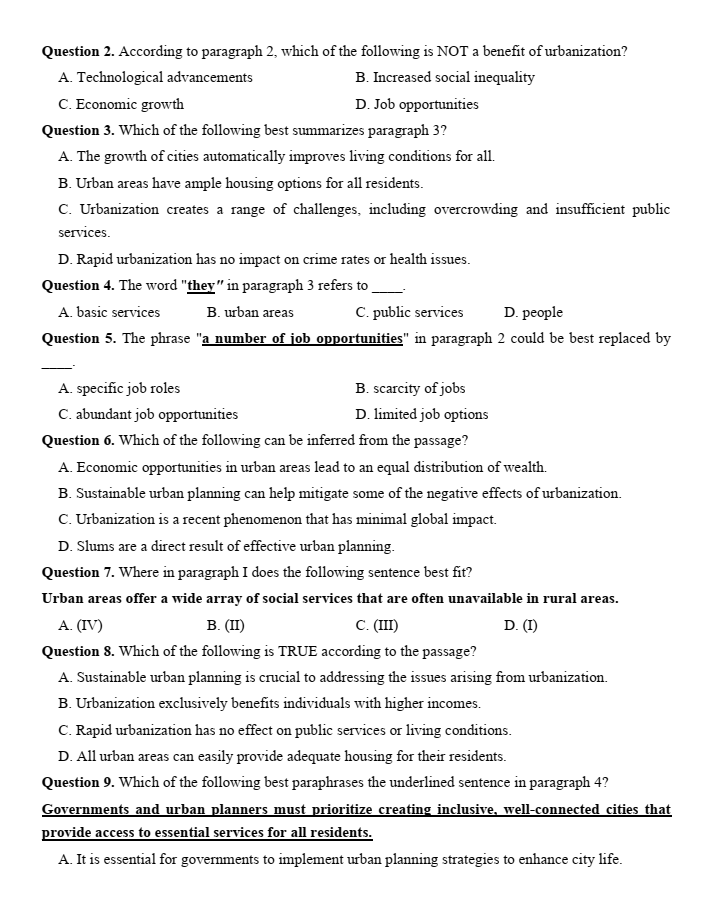
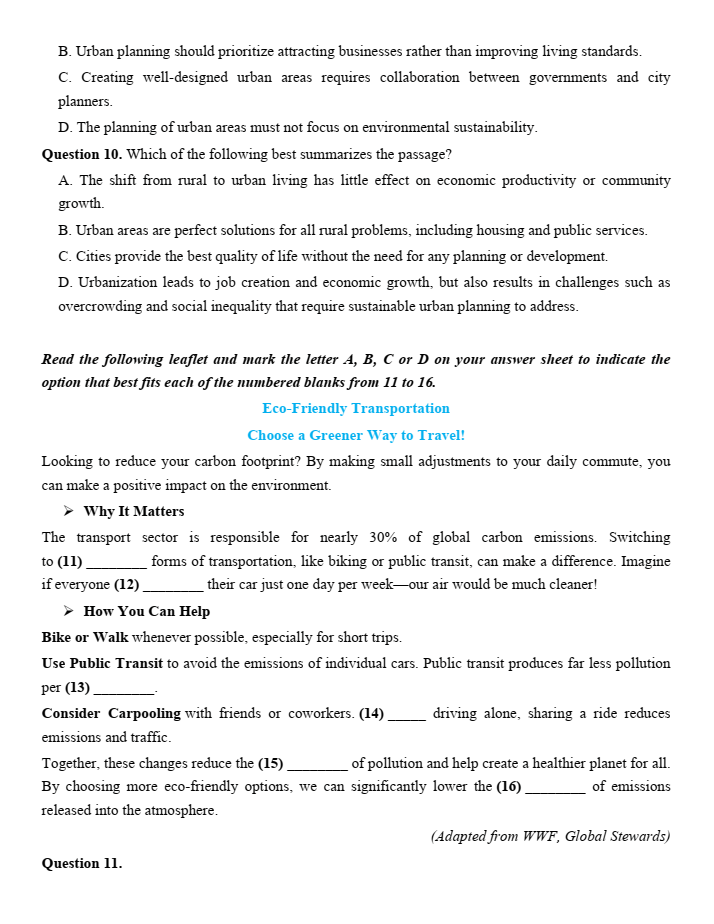
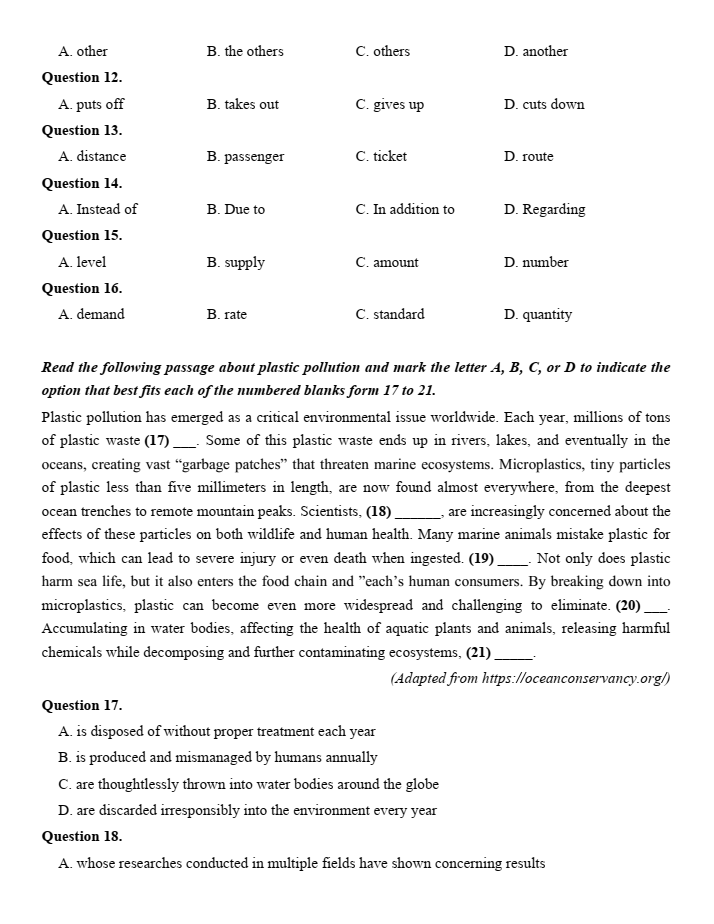
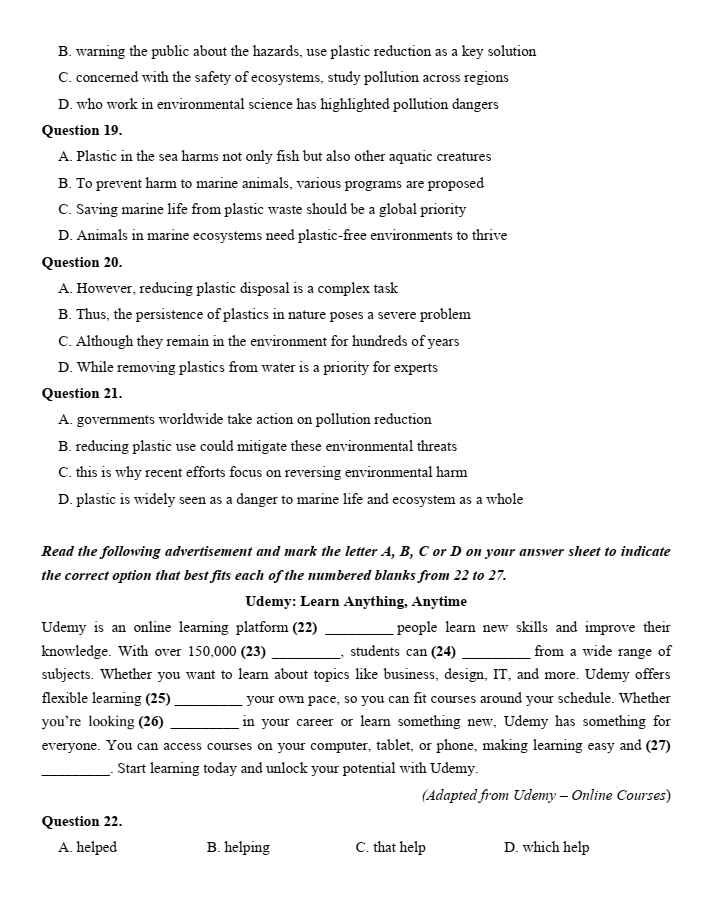
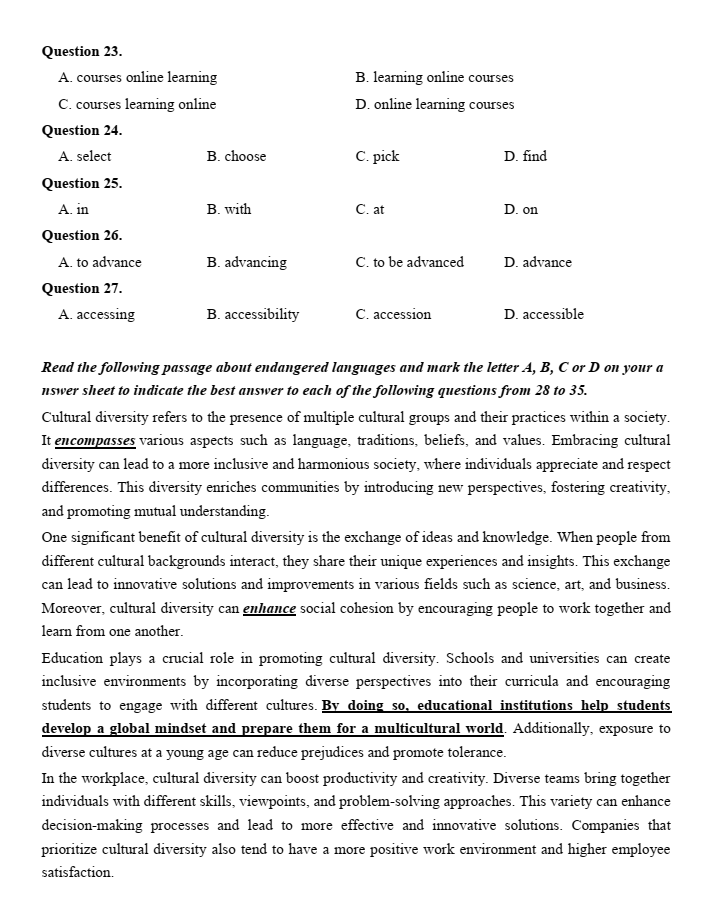
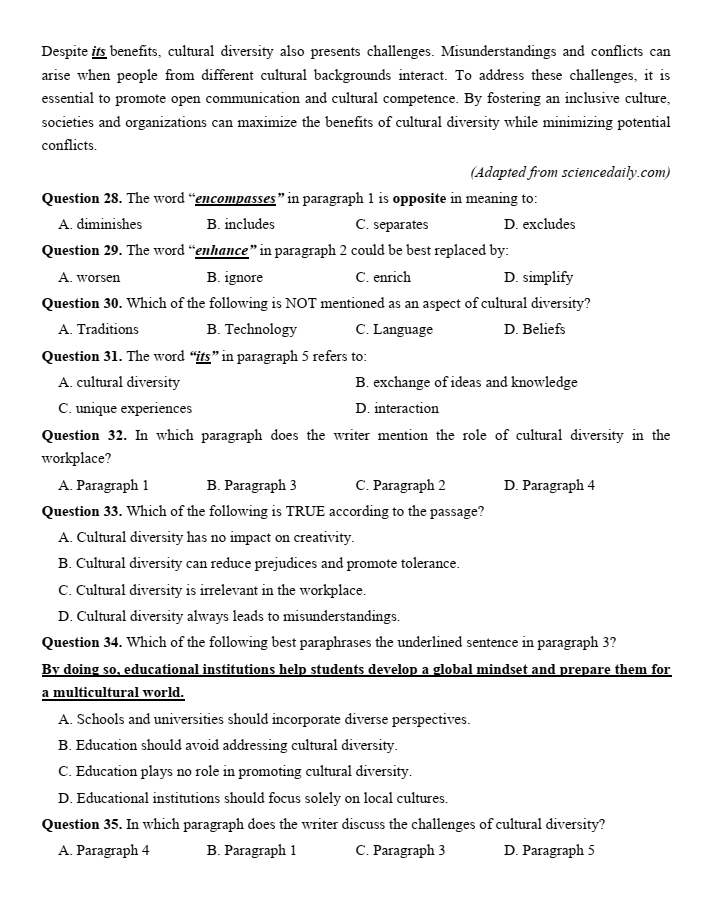
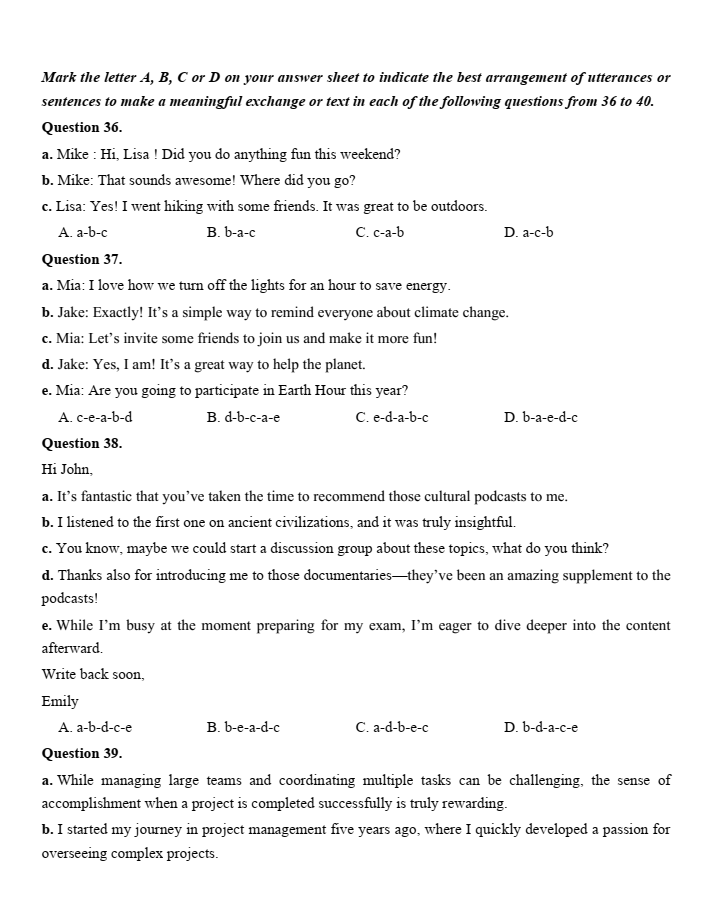
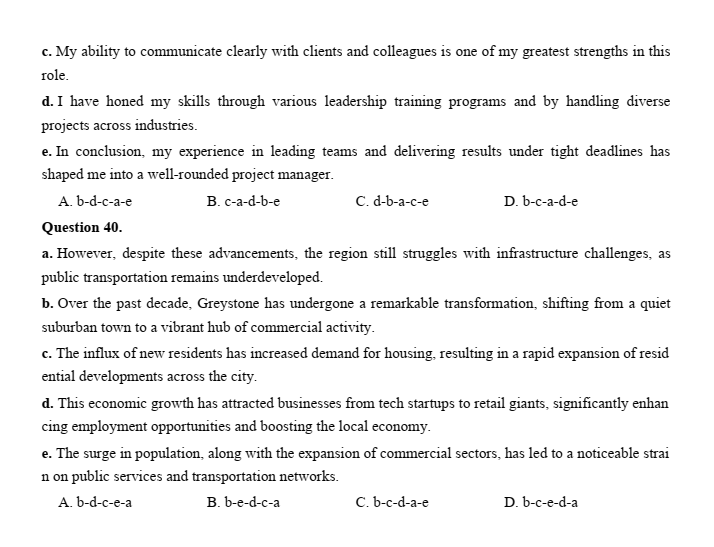
Read the following passage about lifelong learning and mark the letter A, B, C, or D on your answer sheet to indicate the best answer to each of the following questions from 1 to 10.
(I) Urbanization refers to the increasing population shift from rural to urban areas, resulting in the growth of cities and metropolitan regions (Hall, 2014). (II) This phenomenon is driven by various factors, including economic opportunities, improved living standards, and social amenities available in urban centers. (III) As a result, urbanization significantly impacts both individuals and communities, leading to a range of benefits and challenges (Davis, 2016). (IV)
One of the primary advantages of urbanization is the economic growth it fosters. Cities often provide **a number of job opportunities**, attracting individuals seeking better employment and higher incomes. In urban areas, businesses flourish due to increased demand for goods and services, leading to enhanced economic productivity. Moreover, urbanization encourages innovation and technological advancements, as a dense concentration of people often fosters creativity and collaboration (Florida, 2017).
However, urbanization also presents significant challenges. Rapid population growth in cities can lead to overcrowding, straining public services such as transportation, healthcare, and education. Many urban areas struggle to provide adequate housing, resulting in the **proliferation** of informal settlements and slums. According to the United Nations (2018), nearly one billion people live in slums, lacking access to basic services. **They** also face adverse living conditions. This situation exacerbates social inequality and can lead to increased crime rates and health issues.
To address the challenges of urbanization, sustainable urban planning is essential. **Governments and urban planners must prioritize creating inclusive, well-connected cities that provide access to essential services for all residents.** Strategies such as developing affordable housing, enhancing public transport systems, and promoting green spaces can help improve the quality of life in urban areas while mitigating the negative impacts of urbanization (World Bank, 2019).
(Adapted from Urbanization and Its Impact by Hall, Davis, and others)
Question 1. The word “**proliferation**” in paragraph 3 is OPPOSITE in meaning to ______.
A. reduction
B. increase
C. stabilization
D. disappearance
Question 2. According to paragraph 2, which of the following is NOT a benefit of urbanization?
A. Technological advancements
B. Increased social inequality
C. Economic growth
D. Job opportunities
Question 3. Which of the following best summarizes paragraph 3?
A. The growth of cities automatically improves living conditions for all.
B. Urban areas have ample housing options for all residents.
C. Urbanization creates a range of challenges, including overcrowding and insufficient public services.
D. Rapid urbanization has no impact on crime rates or health issues.
Question 4. The word “**they**” in paragraph 3 refers to ______.
A. basic services
B. urban areas
C. public services
D. people
Question 5. The phrase “**a number of job opportunities**” in paragraph 2 could be best replaced by ______.
A. specific job roles
B. scarcity of jobs
C. abundant job opportunities
D. limited job options
Question 6. Which of the following can be inferred from the passage?
A. Economic opportunities in urban areas lead to an equal distribution of wealth.
B. Sustainable urban planning can help mitigate some of the negative effects of urbanization.
C. Urbanization is a recent phenomenon that has minimal global impact.
D. Slums are a direct result of effective urban planning.
Question 7. Where in paragraph I does the following sentence best fit?
Urban areas offer a wide array of social services that are often unavailable in rural areas.
A. (IV)
B. (II)
C. (III)
D. (I)
Question 8. Which of the following is TRUE according to the passage?
A. Sustainable urban planning is crucial to addressing the issues arising from urbanization.
B. Urbanization exclusively benefits individuals with higher incomes.
C. Rapid urbanization has no effect on public services or living conditions.
D. All urban areas can easily provide adequate housing for their residents.
Question 9. Which of the following best paraphrases the underlined sentence in paragraph 4?
Governments and urban planners must prioritize creating inclusive, well-connected cities that provide access to essential services for all residents.
A. It is essential for governments to implement urban planning strategies to enhance city life.
B. Urban planning should prioritize attracting businesses rather than improving living standards.
C. Creating well-designed urban areas requires collaboration between governments and city planners.
D. The planning of urban areas must not focus on environmental sustainability.
Question 10. Which of the following best summarizes the passage?
A. The shift from rural to urban living has little effect on economic productivity or community growth.
B. Urban areas are perfect solutions for all rural problems, including housing and public services.
C. Cities provide the best quality of life without the need for any planning or development.
D. Urbanization leads to job creation and economic growth, but also results in challenges such as overcrowding and social inequality that require sustainable urban planning to address.
Read the following leaflet and mark the letter A, B, C or D on your answer sheet to indicate the option that best fits each of the numbered blanks from 11 to 16.
Eco-Friendly Transportation
Choose a Greener Way to Travel!
Looking to reduce your carbon footprint? By making small adjustments to your daily commute, you can make a positive impact on the environment.
➢ Why It Matters
The transport sector is responsible for nearly 30% of global carbon emissions. Switching to (11)______ forms of transportation, like biking or public transit, can make a difference. Imagine if everyone (12)______ their car just one day per week—our air would be much cleaner!
➢ How You Can Help
Bike or Walk whenever possible, especially for short trips.
Use Public Transit to avoid the emissions of individual cars. Public transit produces far less pollution per (13)______.
Consider Carpooling with friends or coworkers. (14)______ driving alone, sharing a ride reduces emissions and traffic.
Together, these changes reduce the (15)______ of pollution and help create a healthier planet for all. By choosing more eco-friendly options, we can significantly lower the (16)______ of emissions released into the atmosphere.
(Adapted from WWF, Global Stewards)
Question 11.
A. other
B. the others
C. others
D. another
Question 12.
A. puts off
B. takes out
C. gives up
D. cuts down
Question 13.
A. distance
B. passenger
C. ticket
D. route
Question 14.
A. Instead of
B. Due to
C. In addition to
D. Regarding
Question 15.
A. level
B. supply
C. amount
D. number
Question 16.
A. demand
B. rate
C. standard
D. quantity
Read the following passage about plastic pollution and mark the letter A, B, C or D to indicate the option that best fits each of the numbered blanks 17 to 21.
Plastic pollution has emerged as a critical environmental issue worldwide. Each year, millions of tons of plastic waste (17)______. Some of this plastic waste ends up in rivers, lakes, and eventually in the oceans, creating vast “garbage patches” that threaten marine ecosystems. Microplastics, tiny particles of plastic less than five millimeters in length, are now found almost everywhere, from the deepest ocean trenches to remote mountain peaks. Scientists, (18)______, are increasingly concerned about the effects of these particles on both wildlife and human health. Many marine animals mistake plastic for food, which can lead to severe injury or even death when ingested. (19)______. Not only does plastic harm sea life, but it also enters the food chain and “each’s human consumers. By breaking down into microplastics, plastic can become even more widespread and challenging to eliminate. (20)______. Accumulating in water bodies, affecting the health of aquatic plants and animals, releasing harmful chemicals while decomposing and further contaminating ecosystems, (21)______.
(Adapted from https://oceanconservancy.org/)
Question 17.
A. is disposed of without proper treatment each year
B. is produced and mismanaged by humans annually
C. are thoughtlessly thrown into water bodies around the globe
D. are discarded irresponsibly into the environment every year
Question 18.
A. whose researches conducted in multiple fields have shown concerning results
B. warning the public about the hazards, use plastic reduction as a key solution
C. concerned with the safety of ecosystems, study pollution across regions
D. who work in environmental science has highlighted pollution dangers
Question 19.
A. Plastic in the sea harms not only fish but also other aquatic creatures
B. To prevent harm to marine animals, various programs are proposed
C. Saving marine life from plastic waste should be a global priority
D. Animals in marine ecosystems need plastic-free environments to thrive
Question 20.
A. However, reducing plastic disposal is a complex task
B. Thus, the persistence of plastics in nature poses a severe problem
C. Although they remain in the environment for hundreds of years
D. While removing plastics from water is a priority for experts
Question 21.
A. governments worldwide take action on pollution reduction
B. reducing plastic use could mitigate these environmental threats
C. this is why recent efforts focus on reversing environmental harm
D. plastic is widely seen as a danger to marine life and ecosystem as a whole
Read the following advertisement and mark the letter A, B, C or D on your answer sheet to indicate the correct option that best fits each of the numbered blanks from 22 to 27.
Udemy: Learn Anything, Anytime
Udemy is an online learning platform (22)______ people learn new skills and improve their knowledge. With over 150,000 (23)______ students can (24)______ from a wide range of subjects. Whether you want to learn about topics like business, design, IT, and more, Udemy offers flexible learning (25)______ your own pace, so you can fit courses around your schedule. Whether you’re looking (26)______ in your career or learn something new, Udemy has something for everyone. You can access courses on your computer, tablet, or phone, making learning easy and (27)______. Start learning today and unlock your potential with Udemy.
(Adapted from Udemy – Online Courses)
Question 22.
A. helped
B. helping
C. that help
D. which help
Question 23.
A. courses online learning
B. learning online courses
C. courses learning online
D. online learning courses
Question 24.
A. select
B. choose
C. pick
D. find
Question 25.
A. in
B. with
C. at
D. on
Question 26.
A. to advance
B. advancing
C. to be advanced
D. advance
Question 27.
A. accessing
B. accessibility
C. accession
D. accessible
Read the following passage about endangered languages and mark the letter A, B, C or D on your answer sheet to indicate the best answer to each of the following questions from 28 to 35.
Cultural diversity refers to the presence of multiple cultural groups and their practices within a society. It **encompasses** various aspects such as language, traditions, beliefs, and values. Embracing cultural diversity can lead to a more inclusive and harmonious society, where individuals appreciate and respect differences. This diversity enriches communities by introducing new perspectives, fostering creativity, and promoting mutual understanding.
One significant benefit of cultural diversity is the exchange of ideas and knowledge. When people from different cultural backgrounds interact, they share their unique experiences and insights. This exchange can lead to innovative solutions and improvements in various fields such as science, art, and business. Moreover, cultural diversity can **enhance** social cohesion by encouraging people to work together and learn from one another.
Education plays a crucial role in promoting cultural diversity. Schools and universities can create inclusive environments by incorporating diverse perspectives into their curricula and encouraging students to engage with different cultures. **By doing so, educational institutions help students develop a global mindset and prepare them for a multicultural world.** Additionally, exposure to diverse cultures at a young age can reduce prejudices and promote tolerance.
In the workplace, cultural diversity can boost productivity and creativity. Diverse teams bring together individuals with different skills, viewpoints, and problem-solving approaches. This variety can enhance decision-making processes and lead to more effective and innovative solutions. Companies that prioritize cultural diversity also tend to have a more positive work environment and higher employee satisfaction.
Despite **its** benefits, cultural diversity also presents challenges. Misunderstandings and conflicts can arise when people from different cultural backgrounds interact. To address these challenges, it is essential to promote open communication and cultural competence. By fostering an inclusive culture, societies and organizations can maximize the benefits of cultural diversity while minimizing potential conflicts.
(Adapted from sciencedaily.com)
Question 28. The word “**encompasses**” in paragraph 1 is opposite in meaning to:
A. diminishes
B. includes
C. separates
D. excludes
Question 29. The word “**enhance**” in paragraph 2 could be best replaced by:
A. worsen
B. ignore
C. enrich
D. simplify
Question 30. Which of the following is NOT mentioned as an aspect of cultural diversity?
A. Traditions
B. Technology
C. Language
D. Beliefs
Question 31. The word “**its**” in paragraph 5 refers to:
A. cultural diversity
B. exchange of ideas and knowledge
C. unique experiences
D. interaction
Question 32. In which paragraph does the writer mention the role of cultural diversity in the workplace?
A. Paragraph 1
B. Paragraph 3
C. Paragraph 2
D. Paragraph 4
Question 33. Which of the following is TRUE according to the passage?
A. Cultural diversity has no impact on creativity.
B. Cultural diversity can reduce prejudices and promote tolerance.
C. Cultural diversity is irrelevant in the workplace.
D. Cultural diversity always leads to misunderstandings.
Question 34. Which of the following best paraphrases the underlined sentence in paragraph 3?
By doing so, educational institutions help students develop a global mindset and prepare them for a multicultural world.
A. Schools and universities should incorporate diverse perspectives.
B. Education should avoid addressing cultural diversity.
C. Education plays no role in promoting cultural diversity.
D. Educational institutions should focus solely on local cultures.
Question 35. In which paragraph does the writer discuss the challenges of cultural diversity?
A. Paragraph 4
B. Paragraph 1
C. Paragraph 3
D. Paragraph 5
Mark the letter A, B, C or D on your answer sheet to indicate the best arrangement of utterances or sentences to make a meaningful exchange or text in each of the following questions from 36 to 40.
Question 36.
a. Mike : Hi, Lisa ! Did you do anything fun this weekend?
b. Mike: That sounds awesome! Where did you go?
c. Lisa: Yes! I went hiking with some friends. It was great to be outdoors.
A. a-b-c
B. b-a-c
C. c-a-b
D. a-c-b
Question 37.
a. Mia: I love how we turn off the lights for an hour to save energy.
b. Jake: Exactly! It’s a simple way to remind everyone about climate change.
c. Mia: Let’s invite some friends to join us and make it more fun!
d. Jake: Yes, I am! It’s a great way to help the planet.
e. Mia: Are you going to participate in Earth Hour this year?
A. c-e-a-b-d
B. d-b-c-a-e
C. e-d-a-b-c
D. b-a-e-d-c
Question 38.
Hi John,
a. It’s fantastic that you’ve taken the time to recommend those cultural podcasts to me.
b. I listened to the first one on ancient civilizations, and it was truly insightful.
c. You know, maybe we could start a discussion group about these topics, what do you think?
d. Thanks also for introducing me to those documentaries—they’ve been an amazing supplement to the podcasts!
e. While I’m busy at the moment preparing for my exam, I’m eager to dive deeper into the content afterward.
Write back soon,
Emily
A. a-b-d-c-e
B. b-e-a-d-c
C. a-d-b-e-c
D. b-d-a-c-e
Question 39.
a. While managing large teams and coordinating multiple tasks can be challenging, the sense of accomplishment when a project is completed successfully is truly rewarding.
b. I started my journey in project management five years ago, where I quickly developed a passion for overseeing complex projects.
c. My ability to communicate clearly with clients and colleagues is one of my greatest strengths in this role.
d. I have honed my skills through various leadership training programs and by handling diverse projects across industries.
e. In conclusion, my experience in leading teams and delivering results under tight deadlines has shaped me into a well-rounded project manager.
A. b-d-c-a-e
B. c-a-d-b-e
C. d-b-a-c-e
D. b-c-a-d-e
Question 40.
a. However, despite these advancements, the region still struggles with infrastructure challenges, as public transportation remains underdeveloped.
b. Over the past decade, Greystone has undergone a remarkable transformation, shifting from a quiet suburban town to a vibrant hub of commercial activity.
c. The influx of new residents has increased demand for housing, resulting in a rapid expansion of residential developments across the city.
d. This economic growth has attracted businesses from tech startups to retail giants, significantly enhancing employment opportunities and boosting the local economy.
e. The surge in population, along with the expansion of commercial sectors, has led to a noticeable strain on public services and transportation networks.
A. b-d-c-e-a
B. b-e-d-c-a
C. b-c-d-a-e
D. b-c-e-d-a
Mục đích tổ chức kỳ thi Đại học năm 2025 là gì?
Căn cứ theo quy chế hiện hành của Bộ Giáo dục và Đào tạo và các văn bản hướng dẫn tổ chức kỳ thi Đại học năm 2025, mục đích của kỳ thi là:
– Đánh giá kết quả học tập của học sinh sau 12 năm học theo yêu cầu của chương trình giáo dục phổ thông.
– Lấy kết quả thi để xét công nhận tốt nghiệp trung học phổ thông và làm căn cứ tuyển sinh đại học, cao đẳng.
– Góp phần đánh giá chất lượng giáo dục của địa phương và cả nước, làm cơ sở điều chỉnh nội dung, phương pháp dạy học trong nhà trường.
Thí sinh thi Đại học năm 2025 có bắt buộc thi môn Tiếng Anh không?
Theo quy định hiện hành của Bộ Giáo dục và Đào tạo và hướng dẫn tổ chức kỳ thi tốt nghiệp Đại học năm 2025, thí sinh dự thi phải thực hiện như sau:
– Thi 3 môn bắt buộc: Toán, Ngữ văn và Ngoại ngữ.
– Ngoài ra, thí sinh phải chọn một trong hai bài thi tổ hợp: Khoa học Tự nhiên (gồm các môn Vật lí, Hóa học, Sinh học) hoặc Khoa học Xã hội (gồm các môn Lịch sử, Địa lí, Giáo dục công dân – dành cho học sinh học chương trình giáo dục phổ thông).
Trong số các môn thi, Tiếng Anh là một trong ba môn thuộc bài thi Ngoại ngữ bắt buộc, thí sinh phải thi môn Tiếng Anh như một môn bắt buộc, không phụ thuộc vào lựa chọn bài thi tổ hợp hay mục đích xét tuyển đại học.
Như vậy, kỳ thi Đại học năm 2025 bắt buộc thí sinh phải thi môn Tiếng Anh.

